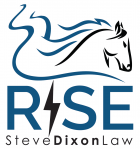Recently, social media went abuzz with a viral video of a moose chasing a golf cart at the Park City Golf Club in Utah (a very fun and gorgeous golf course by the way – I played pretty well there during my one and only visit. Although I did not get chased by any moose). As I watched the moose chase the golf cart down the course, my mind (for better or worse) turned to thinking about the legal ramifications of a moose on the golf course, and any potential injuries that could arise therefrom.
If you’ve ever played golf, even just once, you may have noticed some type of sign or other posting notifying golfers that if they cause any damage to a home (like a window), cart, or even other golfers, the offending golfer and not the golf course or homeowner is responsible. I’ve played several rounds of golf with lots of people who ask me, when they find out that I’m an attorney, whether that statement is true. Are they really responsible if one of their errant shots breaks a window of a home that sits near the course? Most people just assume that yes, they are automatically responsible. But the law actually says otherwise.
The legal doctrine known as “assumption of the risk” applies in these types of situations. Assumption of the risk is a defense in the law of torts, which bars or reduces a plaintiff‘s right to recovery against a negligent tortfeasor if the defendant can demonstrate that the plaintiff voluntarily and knowingly assumed the risks at issue inherent to the dangerous activity in which he was participating at the time of his or her injury. See Vargo, John F. (1978). “Comparative Fault: A Need for Reform of Indiana Tort Law”. Indiana Law Review. 11: 832.
Assumption of the risk applies to other golfers on the golf course, people who buy houses near the golf course, property of the golf course (like a golf cart), etc. Perhaps not surprisingly in our litigious society, there is more than one lawsuit involving negligence and golfers on a golf course. The most recent high profile case comes from California in Shin v. Ahn, 64 Cal.Rptr. 3d 803. According to the case overview,
“Plaintiff and defendant were playing golf with Jeffrey Frost at the Rancho Park Golf Course in Los Angeles. Defendant, the first of the threesome to complete the 12th hole, went to the 13th tee box. Plaintiff and Frost then finished putting and followed him. Frost took the cart path to the 13th tee box, which placed him perpendicular to, or slightly behind, defendant and to his right. Plaintiff took a shortcut, which placed him in front of defendant and to his left. Plaintiff stopped there to get a bottle of water out of his golf bag and to check his cell phone for messages. He did so even though he knew (1) that he was in front of the tee box, (2) that defendant was preparing to tee off, and (3) that he should stand behind a player who was teeing off. Defendant inadvertently “pulled” his tee shot to the left, hitting plaintiff in the temple. When struck, plaintiff was 25 to 35 feet from defendant, at a 40- to 45-degree angle from the intended path of the ball. Plaintiff claims his injuries were “disabling, serious, and permanent … .”’
The plaintiff in that case ultimately sued the defendant for negligence, assault and battery, and recklessness. While the California higher court affirmed that Defendant’s motion for summary judgment was improperly granted because issues of fact remained about whether the shot was reckless, it also stated, “golfers have a limited duty of care to other players, breached only if they intentionally injure them or engage in conduct that is so reckless as to be totally outside the range of the ordinary activity involved in the sport.” Id. at 814.
The result, therefore, is that if you participate in sports, including golf, you assume the risks inherent with that sport. That doctrine applies to any sport including swimming, skiing, basketball, baseball, and others including golf. For example, if you get hit by an errant baseball while sitting in the stands at a baseball game, you’ve assumed that risk. The batter, the team, and the stadium would not be responsible. The same holds true for golf. If you get hit by an errant tee shot, your chances of proving negligence against the person who hit the shot are very slim.
As a side note, for people looking to purchase a golf course home this means you should do your due diligence. Take the time to ask around which houses regularly get hit. If you aren’t familiar with golf, ask a golfer to assess where errant shots could go. In addition, homeowners need to realize even the best golfers (or baseball players, swimmers, basketball players) are going to hit errant shots or perform some act that could result in injury because of the nature of the sport.
In short, by participating in a sport (or owning a home on a golf course0, you assume the inherent risks of being involved in those sports. That assumption could bar any recovery for injuries allegedly caused by the negligent actions of others.

